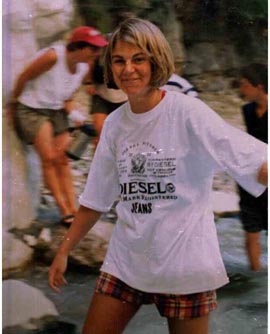Search and rescue teams combed the Chao Phraya River for a body. Tabloid headlines exploded when it was found, then worked overtime to supply breathless updates to a public ravenous for details about what happened.
That was in 1959. The missing woman was Nualchawee Petchrung, a nurse whose body was found floating in Bangkok’s arterial river near the Nonthaburi Bridge. Though the details varied, the media furor and public fixation could be easily mistaken for that happening today following the death of Nida “Tangmo” Patcharaveerapong.
There were profiles on potential suspects and victims, unending interviews that went from witnesses and bystanders to people not even remotely related, consultations with spiritualists, and a perpetual supply of rumors and innuendo.
For over two weeks since Tangmo vanished beneath the surface of the water, her death has become a singular focus. Tune into the mainstream media, Line group chats, social media, and private conversations, and you’d have a hard time knowing war was breaking out in Europe, as news outlets and Twitter dissect every update and speculate wildly about every facet of the late 37-year-old woman’s life – and death.
In fact, we as a society seem unusually obsessed with women who are victims of calamity, whether it’s the worst kind of inflicted violence or accidental. The public consumes every gruesome detail imaginable, from the brutal dismemberment of a karaoke lounge sex worker to a model drugged and dragged through a hallway to be sexually assaulted before – or possibly after – her death.
Whether motivated by crass voyeurism or a frustrated desire for undelivered justice, we don’t seem able to turn away. But after the last secret is exposed and rumor traded – and attentions turned elsewhere – has the crucible of public inspired meaningful change?
History suggests otherwise. Here are eight times all of Thailand’s become collectively obsessed with bad things happening to women, and then moved on.
Nida “Tangmo” Patcharaveerapong: Unlucky in love; unlucky in life; exploited by all

The story of Tangmo began dominating the news cycle as soon as the search began after she fell from a speedboat two Fridays ago. Much of the obsession with the 37-year-old actress’ death seems to stem from an impotent rage over people of privilege getting away with things, as well as the unhappy events which punctuated her life.
Search resumes for actress who fell from boat into Chao Phraya River
By the time her body was found, a potent mix of fact and rumor fed suspicions that her companions, including her longtime manager, were hiding a secret. Turn on any television, pick up any daily newspaper, or overhear any conversation – Tangmo is still on everyone’s lips today.
Investigators said they will close the case tomorrow.
UPDATE: Explosive eyewitness claims push police to continue Tangmo investigation
Waraluck ‘Doctor Kratai’ Supawatjariyakul: Gifted doctor’s promising future cut short by bad cop

Though it was just weeks before Tangmo’s death, it seems like ages ago that the entire nation’s attention was fixed on a woman eye doctor killed at a zebra crossing by a cop speeding on an unlicensed Ducati motorcycle.
He didn’t even stick around, and the bad cop trope catalyzed the good-daughter doctor narrative quickly had everyone seeing red and demanding justice. For about four weeks, the entire country swung between sadness and outrage on a steady diet of her biography – and his attempts to sidestep accountability.
Cop kills gifted Bangkok eye doctor, testing pledges for safer roads
Outcome? The case put forward a very practical issue: Thailand’s miserable road safety. But rather than address the root cause – a culture of carelessness and impunity by ramping up enforcement and raising awareness, – the government literally whitewashed its response by sending work crews out to repaint the crosswalks being ignored in the first place.
Thitim “Bell” Noraphiphat: Eye candy, sex object, working mom left like trash in lobby

In September 2019, model Thitim “Bell” Noraphipat was found dead in the lobby of a Bangkok apartment after a night out.
As the story emerged, Thitim’s job in the margins as a promotional model, aka pretty, led her to attending a paid gig at a VIP party where she passed out from drugs and alcohol – some believed intentionally – and dragged off by a male model who placed her barely conscious body in his car and raced back to his Thonburi condo.
Amid questions over whether Thitim – better known as Lunlabelle – was even still alive when she was assaulted there, forensic examiners found traces of semen and even tears inside her vagina.
What transpired next in this crime made for social media were amateur attempts to piece together her final moments from leaked chat logs, Instagram posts and Line messages, including those of her rapist, Rachadech Wongthabutr. All were being pored over by armchair investigators as YouTube filled with grainy CCTV clips of him dragging her unmoving body through the halls of his condo into and out of his room.
Pretty Girls Taking Risks: Inside the world of Thailand’s models for hire
Then what? Thitim’s death shed some light on the shady going-ons of the entertainment industry and the dangers faced by promotional models. Rachadech was convicted of kidnapping and raping Thitim and sentenced to eight years in jail, but never served a day and remains free to post photos of his fake abs on an almost daily basis.
Warissara “Amm” Klinjui: Wrath of the Murder Babes

In May 2017, bar girl Warissara “Amm” Klinjui was found sawed in half and deposited inside hastily buried buckets. If that wasn’t enough to get the ink spilling, the three suspects that emerged inspired a celebrity cult. Preeyanuch “Preaw” Nonwangchai, Kawita “Earn” Ratchada, and Apiwan “Jae” Sattayabundit charmed cops and turned heads with their sexy social media photos that had men everywhere declaring for #TeamPreaw.
Dismembered Khon Kaen bar girl was police drug snitch, says one suspect
Soon dubbed the “Murder Babes” for their youth and apparent viciousness, photos emerged of the “babes” getting special treatment by the police. They slept in rainbow-colored blankets that were soon selling out online alongside “saw” keychains representing their tool of dismemberment.
Predictably, this all prompted a backlash. People criticized the police’s friendly attitudes toward the girls, and news coverage that seemed to propagate a redemption arc for the women because they turned themselves in – after first going on the run across international borders.
So what did it all mean? Coming in 2017, the story of the murder babes was the first where social media took the lead over traditional media, with pages like Ejan leading the way. That gave the junta ammunition for its “media reform bill” – a thinly veiled move toward state media control – that has failed to move forward but, as of today, has been resurrected to establish a state-backed “media council.” Not all change is good.
Kochakorn “Kaem” Pitakjumnong: Incalculably cruel fate for anyone’s daughter

In what is probably one of the most vile crimes in recent memory, 13-year-old Kochakorn “Kaem” Pitakjumnong was thrown out from a Bangkok-bound train after being raped by a railway employee.
Her 2014 murder, which anguished the nation’s parents projecting their own worst fears, led to calls to revive capital punishment, which had been been quietly shelved with no one executed since 2009.
Autopsy: Teen died from impact after being raped, thrown from train
Was there justice? Wanchai Sangkhao, Kochakorn’s killer, was indeed sentenced to die, but continues to languish on death row today. This and subsequent episodes of sexual violence led to more calls for state executions to resume. Four years later, 26-year-old Theerasak Longji was executed by lethal injection.
Johanne Masheder: Backpacker, free spirit, raped and murdered by bad monk

Johanne Masheder was touring the world after finishing law school when her travels came to a violent end in Thailand in late 1995.
What so incensed the public was that the 23-year-old Englishwoman’s murderer and rapist was ostensibly a holy man, a monk named Yodchat Suaphu, who robbed, killed, and dumped her in a cave.
He was swiftly defrocked and given the death penalty, but his sentence was later commuted to life.
The murder rocked Buddhism and led to measures to better monitor temples and their monks, including establishing an identification system.
Kirsty Jones: A 20-year case that ultimately went unsolved

Kirsty Jones was another British backpacker when she arrived at a Chiang Mai guest house in August 2000. That’s where she was found raped and strangled by a sarong.
Many people were arrested but no one was charged. The authorities handling the case were criticized for a bungled investigation, including the arrest of multiple foreigners and attempt to scapegoat Burmese nationals – one of whom was taken into custody and beaten.
Despite widespread coverage and international attention, the grew cold until, just two years ago, the case was closed on the 20th anniversary of her murder.
Nualchawee Pethrung: Respected doctor orders hit on wife

One of the earliest examples of sensational coverage in the modern era came in 1959, in a case with parallels to that of Tangmo. It started when the body of nurse Nualchawee Petchrung was found floating in the Chao Phraya River, and ended with her husband, physician Athip Suyansethakarn, convicted of premeditated murder.
The story of a man with a respectable job killing his wife made front page headlines daily. Though Athip was given the death sentence, he was pardoned but not allowed to resume medicine.
Among the unsavory details which emerged to grip imaginations: One of the associates Athip hired to kill his wife even raped her with his permission before subduing her with chloroform.
Since the nurse’s death, the bridge where her body was found is better known by locals not as Nonthaburi Bridge but as the Nualchawee Bridge. The film was also adapted into a 1985 biographical drama film titled Nualchawee, as well as a 2003 TV drama titled Pom Rak Nualchawee.
Nong Chompoo: The upside-down world of celebrity-suspect ‘Uncle Pon’

In one of the strangest media phenomena, public attention fixed on a toddler found naked and dead in a forest was grafted onto the lead suspect in her death, her 44-year-old uncle.
It didn’t take long for interest in Orawan “Nong Chompoo” Wongsricha’s May 2020 death to be hijacked by another media compulsion: the celebration of the down-luck everyman, Chaiphol Wipha.
The Ballad of Uncle Pon: Thai media goes off the rails turning suspect into superstar
Chaiphol became “Uncle Pon,” launched a singing career, appeared at countless paid events all made possible by an unblinking tabloid obsession with his salt-of-the-earth roots. Frustrated reporters quit news organizations such as Amarin TV, which made cashing in on his celebrity a higher priority than looking into his possible guilt.
As of now, Chaiphol has been arrested, charged with physical and sexual assault, and is now free on bail awaiting trial, but only after a year of the high life made possible by a credulous public.
Additional reporting Chayanit Itthipongmaetee


